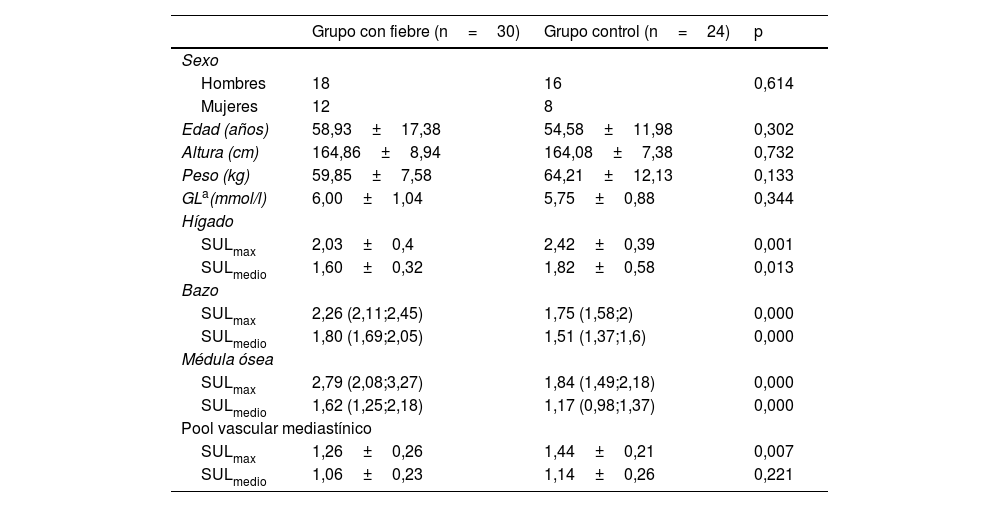La fiebre puede afectar a la identificación y la evaluación de la respuesta de los tumores en la PET/TC con [18F]FDG, y dicho efecto puede ser reducido normalizando según el metabolismo tisular normal.
El objetivo del estudio fue analizar la influencia de la fiebre en el metabolismo de la glucosa en el pool vascular mediastínico, hígado, bazo y médula ósea utilizando el parámetro cuantitativo del SUV de la PET/TC normalizado por la masa corporal magra (SUL).
Material y métodosSe analizaron retrospectivamente 30 pacientes con fiebre de origen desconocido y 24 pacientes remitidos para cribado tumoral con temperatura corporal normal durante un intervalo de 3semanas, todos ellos sometidos a una PET/TC con [18F]FDG en nuestro servicio. En ambos grupos se determinaron el SULmax y el SULmedio del pool vascular mediastínico, de hígado, bazo y médula ósea, y las diferencias entre ambos grupos se compararon mediante una prueba t-test, o una prueba de Wilcoxon-Mann-Whitney para muestras independientes.
ResultadosLos valores de SULmax y SULmedio del hígado en el grupo con fiebre fueron inferiores a los del grupo control (p=0,001, 0,013). El SULmax y SULmedio de bazo y médula ósea en el grupo con fiebre fueron mayores que en el grupo control (todos con p<0,05). El SULmax del pool vascular mediastínico en el grupo con fiebre fue menor que en el grupo control (p=0,007), pero no hubo diferencia significativa en el SULmedio del mediastino entre el grupo con fiebre y el grupo control (t=1,181, p=0,221).
ConclusiónLa fiebre puede afectar al metabolismo de la glucosa en los órganos internos. Sin embargo, no hubo diferencia significativa en el SULmedio del pool vascular mediastínico. Tal vez el SULmedio del pool vascular pudiera constituir un parámetro de calibración en la evaluación de la eficacia terapéutica en pacientes oncológicos con fiebre.
Fever can affect the identification and efficacy evaluation of tumors on the 18F-FDG PET/CT, and this effect can be reduced by referring to normal tissue metabolism.The aim of the study was to analyze the influence of fever on glucose metabolism in the mediastinal blood pool, liver, spleen, and bone marrow utilizing PET/CT quantitative parameter SUV normalized by lean body mass(SUL).
Materials and methods30 patients with fever of unknown origin and 24patients for tumor screening with normal body temperature within 3weeks, who underwent 18F-FDG PET/CT in our department, were analysed retrospectively. The SULmax and SULmean of the mediastinal blood pool, liver, spleen, and bone marrow were respectively measured in the two groups, and the differences between the two groups were compared by independent sample t test or Wilcoxon-Mann-Whitney test.
ResultsThe SULmax and SULmean of the liver in the fever group were lower than those in the control group (P=.001, .013). The SULmax and SULmean of spleen and bone marrow in the fever group were higher than in the control group (all P<.05). The SULmax of the mediastinal blood pool in the fever group was lower than that in the control group (P=.007), but there was no significant difference in SULmean of the mediastinal between the fever group and the control group (T=1.181, P=.221).
ConclusionThe fever can affect the glucose metabolism in internal organs. But there was no significant difference in the SULmean of mediastinal blood pool. Perhaps the SULmean of the blood pool can be invoked as a calibration parameter in the evaluation of efficacy in tumor patients with fever.
Artículo
Si tiene problemas de acceso puede contactar con la Secretaría Técnica de la SEMNIM en el correo electrónico secretaria.tecnica@semnim.es o en el teléfono: + 34 619 594 780









